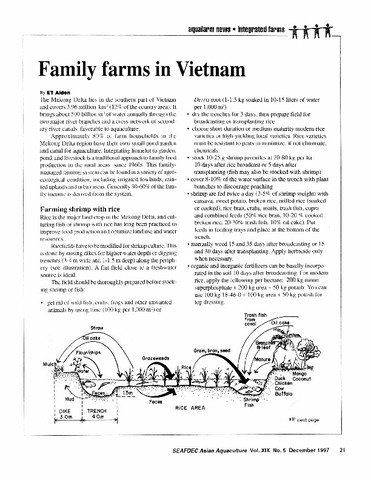Perlihatkan publikasi sederhana
Supporting ASEAN good aquaculture practices: Utilization of alternative protein sources for aquafeed to minimize pressure on fishery resources
| dc.contributor.author | Mamauag, Roger Edward | |
| dc.date.accessioned | 2016-11-04T06:34:11Z | |
| dc.date.available | 2016-11-04T06:34:11Z | |
| dc.date.issued | 2016 | |
| dc.identifier.citation | Mamauag, R. E. P. (2016). Supporting ASEAN good aquaculture practices: Utilization of alternative protein sources for aquafeed to minimize pressure on fishery resources. Fish for the People, 14(2), 83-89. | en |
| dc.identifier.issn | 1685-6546 | |
| dc.identifier.uri | http://hdl.handle.net/20.500.12066/390 | |
| dc.description.abstract | Aquaculture industry of Southeast Asia has been expanding steadily as a result of an increasing demand of food fish in the region as well as in the global scale. Aside from its contribution to the world’s fisheries, the aquaculture industry creates employment opportunities and provides income for the region’s fish farmers, as well as produces fish which is a major component in the diets of peoples in Southeast Asia. However, the fast development of aquaculture had been viewed as threat to sustainable capture fisheries production as the widespread use of fish by-catch in aquaculture feeds results in overexploitation of the fishery resources and to certain extent degradation of the resources. Recognizing the importance and urgency of addressing such concern, the Senior Officials of the ASEAN Member States responsible for fisheries adopted in June 2011, the Plan of Action on Sustainable Fisheries for Food security for the ASEAN Region Towards 2020 which includes provision on the need to “improve the efficient use of aquatic feeds by strictly regulating the quality of manufactured feed and feed ingredients and support continued research for developing suitable alternative protein sources that will reduce dependence on fishmeal and other fish-based products.” Along with such declaration, the SEAFDEC Aquaculture Department has been enhancing its R&D activities aimed at finding alternatives to fishmeal as feed ingredients in aquaculture feed formulations. | en |
| dc.language.iso | en | en |
| dc.publisher | Secretariat, Southeast Asian Fisheries Development Center | en |
| dc.subject | South East Asia | en |
| dc.title | Supporting ASEAN good aquaculture practices: Utilization of alternative protein sources for aquafeed to minimize pressure on fishery resources | en |
| dc.type | magazineArticle | en |
| dc.citation.volume | 14 | |
| dc.citation.issue | 2 | |
| dc.citation.spage | 83 | |
| dc.citation.epage | 89 | |
| dc.citation.journalTitle | Fish for the People | en |
| dc.subject.asfa | feeds | en |
| dc.subject.asfa | aquaculture regulations | en |
| dc.subject.asfa | aquaculture | en |
| dc.subject.asfa | sustainability | en |
| dc.subject.asfa | feed composition | en |
| dc.subject.asfa | fishmeal | en |
| dc.subject.asfa | fish meal processing | en |
| dc.subject.asfa | aquaculture development | en |
Files in this item
| Files | Size | Format | View |
|---|---|---|---|
| MamauagREP2016.pdf | 769.7Kb | application/pdf | View/ |
Publikasi ini ada di koleksi berikut
-
Fish for the People [41]
These articles were contributed by SEAFDEC/AQD staff to Fish for the People Magazine



